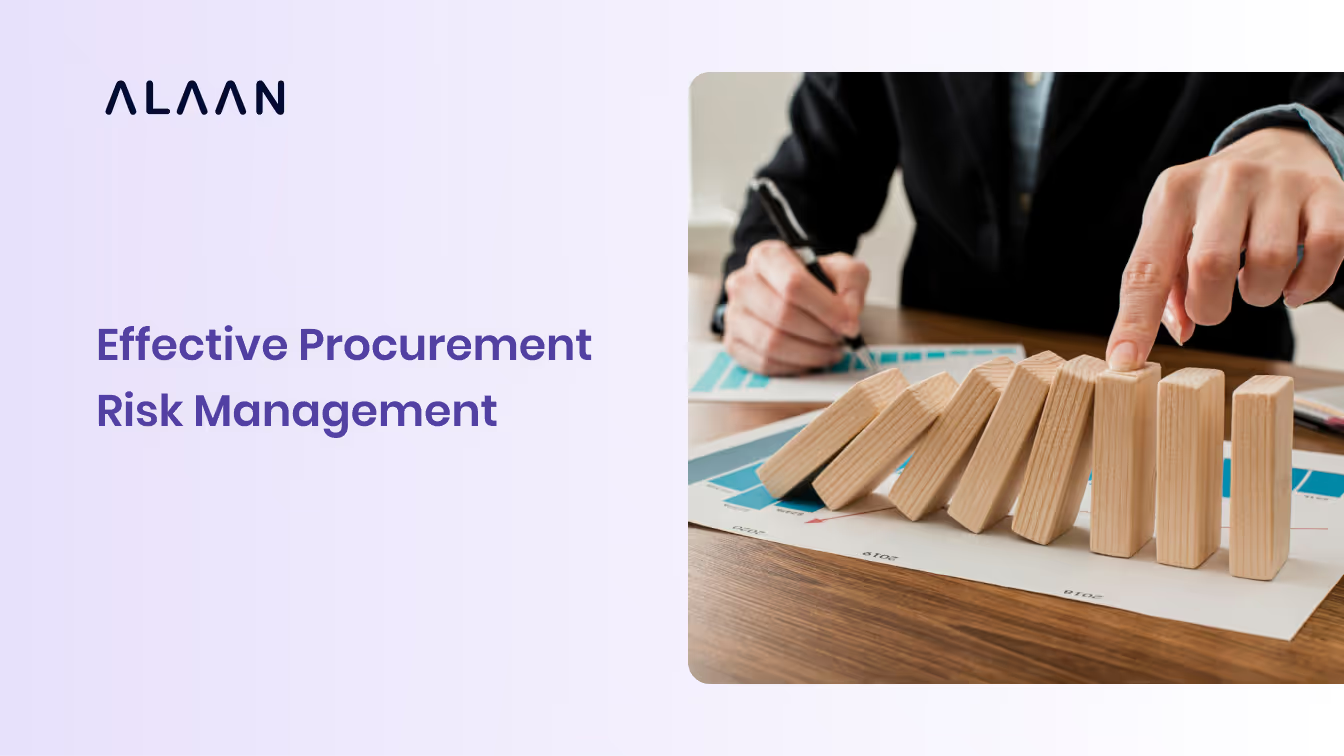You approve a supplier invoice late in the evening, and only then realise a clause hikes your cost by 8 %. A critical shipment arrives behind schedule, and cash-flow projections unravel. These are not mere mishaps, they are shortcuts through which procurement risk seeps in, threatening margins, compliance, and stakeholder trust.
That danger isn't hypothetical. According to one of the recent studies, procurement and operations are among the departments most commonly exploited due to weak internal controls, making these functions prime targets for fraud. Additionally, a 2024 UAE FIU report estimated that payment fraud losses in the MENA region reached US$94 billion, with 42 % of fraud transactions involving outward mobile or online banking transfers.
This escalation means reactive fixes won't cut it. The remedy lies in strategic, systems-level control: supplier risk segmentation, contract guardrails, continuous monitoring, and automation. In the following sections, we'll explore how to reframe procurement from vulnerability to a resilient backbone of your financial control architecture.
In a Nutshell
- Procurement risk extends beyond paperwork: From unreliable suppliers to fraud, cost spikes, and compliance gaps, unmanaged risks drain profits and damage reputation.
- Internal vs. external risks require distinct responses: Automation and controls address internal errors, while diversification, monitoring, and insurance address external shocks.
- Proactive beats reactive measures: Effective risk management predicts and prevents problems instead of chasing late deliveries or fixing duplicate invoices.
- Strategies drive results: Spend analysis, sourcing, supplier development, and continuous monitoring reduce disruption, boost compliance, and strengthen supplier trust.
- The right platform is essential: AI-driven platforms like Alaan cut fraud, ensure VAT compliance, and give CFOs real-time visibility across procurement.
Procurement Risk: What UAE Businesses Must Know
Procurement risk refers to the potential failures in sourcing and purchasing resources, services, or products that can disrupt operations, increase costs, or cause compliance issues. These risks can be internal (originating within the company) or external (stemming from vendors, markets, or broader environments). Each category requires a distinct approach to mitigation.
Major Procurement Risks

1. Poor Supplier Reliability: Delayed shipments, inconsistent product quality, or non-compliance with contracts can impact production schedules and erode profitability.
Example: A UAE-based logistics firm relying on a single overseas supplier for critical parts faces weeks of downtime when that supplier defaults.
2. Needs Misjudgment: Overestimating or underestimating requirements can result in excess stock, cash flow strain, or lost sales opportunities. Weak planning often triggers a chain reaction, affecting budgets, investor confidence, and operational credibility.
Example: A retail chain in Sharjah overorders seasonal inventory without accurate demand forecasts. Unsold stock ties up AED 1 million in warehouse costs and forces heavy markdowns.
3. Procurement Contract Risks & Compliance Gaps: Vague or outdated contracts, coupled with failure to adhere to VAT or regulatory standards, expose businesses to fines and reputational damage.
Example: A Dubai-based construction contractor misses a VAT clause in a subcontractor agreement. During audit, the Federal Tax Authority disallows input VAT claims, resulting in fines and back payments.
4. Human Error: Manual processes, such as handwritten POs, paper invoices, and disconnected approval flows, are prone to mistakes and delays. Missing documents can also complicate audits and VAT filings.
Example: An Abu Dhabi hospitality group loses paper invoices worth AED 250,000 in VAT recoveries due to incomplete documentation and unverified approvals.
5. Supply Chain Delays: External shocks, such as material shortages, logistics bottlenecks, or geopolitical disruptions, directly affect procurement timelines and customer satisfaction.
Example: A food importer experiences shipment delays during Red Sea route diversions, leading to stockouts across supermarkets and penalties from retail partners.
6. Fraud and Corruption: Risks such as fake invoices, collusion, or embezzlement increase in manual procurement systems lacking proper controls, approval hierarchies, or vendor verification.
Example: A mid-sized UAE logistics firm uncovers duplicate payments to a shell vendor after reconciling supplier ledgers. That’s an issue unnoticed for months due to lack of system-based validation.
7. Market and Cost Volatility: Price fluctuations, shifts in demand, or regulatory changes can strain procurement budgets.
Example: Construction firms in the UAE face cost pressures when steel prices surge unexpectedly, affecting project margins.
8. Operational and Cyber Risks: Inefficient systems, limited transparency, or cybersecurity breaches within supplier networks can disrupt procurement workflows and compromise sensitive financial data.
Example: A regional distributor’s supplier portal is hit by a phishing attack, exposing vendor bank details and forcing a two-week payment freeze to prevent financial losses.
9. Environmental Risks: Natural disasters, climate change, or pandemics can disrupt procurement cycles by limiting material availability or delaying logistics.
Example: A Dubai-based FMCG company faces import delays after flooding in supplier regions disrupts raw material availability, forcing production slowdown and emergency procurement at higher costs.
Also Read: Understanding the Procure-to-Pay (P2P) Process
Knowing the risks in the procurement process is only half the battle. The next step is applying clear strategies that help you turn procurement into a resilient, well-controlled process.
Effective Procurement Risk Management: Key Strategies Every Business Needs

Effective procurement risk management is essential for protecting cash flow, ensuring VAT and regulatory compliance, and maintaining supplier reliability. Structured strategies mean fewer disruptions, stronger supplier partnerships, and greater financial resilience, all while freeing teams from the inefficiencies of manual oversight.
With this in mind, let’s look at the most effective methods for managing procurement risks:
1. Spend Analysis
Spend analysis provides a clear view of where money is going and where risks are hiding. It uncovers inefficiencies such as duplicate invoices, redundant purchases, and dependency on specific suppliers.
How it works:
- Review historical transactions to spot overspending, duplicate invoices, or unauthorised spending.
- Identify categories where costs routinely exceed budgets.
- Detect single-supplier dependency for critical goods and services.
Example: Analysing past purchase orders might show that 40% of IT spend goes to a single vendor, signalling both a dependency risk and an opportunity to renegotiate better terms.
Pro Tip: Utilise AI-powered spend management tools like Alaan to automatically identify anomalies, such as “ghost suppliers” or multiple payments against the same invoice.
2. Procurement Transparency
Transparency ensures accountability at every stage, from requisition to payment. Clearly laid down procurement policies, backed by digital trails, ensure every dirham spent is traceable, compliant with VAT rules, and aligned with business objectives.
Practical steps:
- Implement digital approval workflows with clear audit trails.
- Enable department-level budget visibility so procurement managers can track approved vs. actual spending.
- Standardise reporting formats across teams to simplify audits and VAT filings.
Key Insight: Transparency reduces fraud and improves policy compliance. In the UAE, transparent audit trails are critical for proving VAT accuracy during FTA audits.
3. Supplier Consolidation and Diversification
Managing too many suppliers increases complexity, while relying on too few creates vulnerability. Smart consolidation paired with diversification helps you reduce costs, stabilise supply, and safeguard against external shocks.
Approaches:
- Consolidation: Combine low-value or repetitive categories under fewer suppliers to negotiate better terms and reduce logistics costs.
- Diversification: For critical goods, maintain multiple suppliers across different geographies to reduce dependency.
Example: A transport firm can consolidate fuel procurement with two leading suppliers instead of eight. While saving on freight and admin costs, they can also sign a backup contract with a regional provider to guard against shortages.
4. Supplier Relationship Management (SRM)
Strong SRM practices protect you from disruption, strengthen compliance, and unlock long-term value through collaboration and trust.
Steps to strengthen SRM:
- Use supplier performance scorecards (delivery timeliness, defect rates, compliance with VAT invoices).
- Build collaborative partnerships through joint risk assessments and contingency planning.
- Digitise supplier data for visibility across contracts, POs, and invoices.
5. Compliance and Contract Management
Legal and regulatory compliance is especially crucial in the UAE, where penalties for breaches are severe. Proactive compliance and airtight contracts protect against regulatory fines, VAT errors, and costly disputes with vendors.
Best practices:
- Draft contracts with clear obligations on delivery, quality, and compliance with VAT rules.
- Regularly review and update contracts to reflect new regulations.
- Use automation to enforce three-way matching (PO, invoice, goods receipt) to block fraudulent transactions before they’re paid.
Weak contract language can lead to disputes, fines, or reputational damage. For public procurement, non-compliance with government tender laws can bar companies from future bids.
Pro Tip: Include escalation clauses for cost volatility (e.g., fuel or steel prices) and force majeure clauses to cover unexpected events.
6. Procurement Process Automation
Automation transforms procurement into a faster, error-free, and audit-ready function, freeing your procurement and finance teams to focus on value creation rather than firefighting.
Capabilities of automation:
- Digital requisition approvals to speed up cycle times.
- Automated invoice processing to reduce fraud.
- VAT-ready reporting integrated with accounting platforms like QuickBooks or NetSuite.
Key Takeaway: By automating purchase approvals and invoice reconciliation, your finance team can significantly cut processing time and reduce audit errors to near zero. For CFOs, this ensures audit readiness at month-end closings.
[cta-3]
Also Read: Introduction to Automation in Procurement Processes and Workflows
7. Strategic Sourcing
Buying based on the lowest price often backfires. Strategic sourcing moves beyond cost-cutting to align procurement with long-term business goals.
Core elements:
- Category Management: Grouping purchases into categories (e.g., IT services, raw materials, logistics) gives you stronger negotiating power and clearer visibility into supplier performance. Managing categories strategically also prevents overspending on fragmented, one-off deals.
Example: By consolidating your IT software contracts under one category, you could replace scattered team-level subscriptions with an enterprise-wide license. This approach can help cut costs while simplifying renewals.
- Total Cost of Ownership (TCO) Analysis: Evaluating the full lifecycle cost of a product or service, including purchase, delivery, maintenance, compliance, and disposal, prevents short-term savings from turning into long-term losses.
Example: When sourcing equipment, opting for a supplier with a slightly higher upfront price but lower long-term maintenance costs could reduce lifecycle costs. This protects both margins and budget forecasts.
8. Cybersecurity and Data Protection
Digital procurement creates new exposure points. Strong cybersecurity safeguards sensitive financial data, protects supplier networks, and ensures compliance with changing UAE data protection laws.
Action points:
- Select procurement systems that offer encryption and comply with UAE data laws.
- Audit supplier IT systems to ensure they follow similar standards.
- Train procurement teams to recognise phishing or fraudulent invoices.
Why it matters: A breach of supplier systems could expose sensitive contracts and VAT-related data, risking both compliance and reputation.
9. Supplier Development
Procurement risk does not end at contract signing. Investing in supplier development strengthens reliability, reduces quality issues, and builds resilience into the supply chain over the long term.
Approaches:
- Offer training on compliance and VAT requirements.
- Collaborate on technology upgrades (inventory systems, automation).
- Incentivise suppliers with long-term contracts or volume commitments to motivate them to prioritise quality and service consistency.
10. Risk Transfer via Insurance
Not all risks in the procurement process can be avoided. Strategic use of insurance cushions financial exposure from political instability, natural disasters, and unexpected operational disruptions.
- Geopolitical Risk Insurance: Protects against procurement disruptions caused by global events such as the Russia–Ukraine war, regional conflicts, or trade sanctions. This coverage ensures your business can absorb financial shocks.
- Business Interruption Insurance: Covers loss of income and extra expenses if operations halt due to procurement or supply chain breakdowns, such as those experienced during COVID-19 lockdowns.
- Natural Disaster Insurance: Mitigates risks from floods, earthquakes, or drought situations.
- Product Liability Insurance: Safeguards against claims or losses if defective or non-compliant goods from suppliers impact your business.
11. Continuous Monitoring and Improvement
Procurement risks aren’t static; they keep changing with market conditions, supplier performance, and regulatory shifts. Businesses that rely on one-time checks often miss early warning signs of disruption.
Why it matters: Ongoing monitoring gives you real-time visibility into supplier reliability, delivery times, and market price fluctuations. Feeding these insights back into procurement policies and supplier strategies helps make risk management more agile and data-driven.
Practical steps:
- Track KPIs such as delivery accuracy, defect rates, and contract compliance in real time.
- Utilise AI dashboards and alerts to identify anomalies, such as sudden price hikes or repeated policy breaches.
- Conduct regular internal and external audits to identify process gaps.
- Benchmark procurement practices against industry peers in the UAE and MENA regions.
- Establish feedback loops with suppliers and internal stakeholders to refine workflows.
Example: A fast-growing online retailer can use real-time monitoring to spot a sudden spike in freight costs and adjust contracts before peak season. Quarterly reviews of procurement data can then inform new policies, saving both time and money while strengthening compliance.
Key Insight: Monitoring detects risks; improvement transforms responses into long-term growth. Together, they turn procurement from a reactive cost centre into a proactive driver of business stability.
Implementing these strategies is only effective if supported by the right tools. To truly reduce procurement risks, you need a platform that centralises spending, automates controls, and delivers real-time visibility. This is precisely what Alaan provides.
Reducing Procurement Risks Through Smarter Spend Control With Alaan
Without a centralised system, monitoring every dirham spent across suppliers, teams, and categories can quickly spiral out of control. Alaan brings all procurement-related spending into one innovative, AI-powered platform.
- Corporate Cards: Issue unlimited corporate cards with pre-set limits, vendor restrictions, and category controls. Cards are pre-funded, can be instantly blocked or frozen, and come with vendor or category restrictions. This ensures teams spend only within approved budgets, cutting off maverick purchases.
- Automated Expense Recording: Every transaction is logged automatically. Employees upload receipts instantly, while Alaan’s AI captures vendor, amount, and VAT details. Duplicate invoices are flagged, errors are reduced, and manual work is eliminated before disruptions occur.
- Real-Time Dashboards and Insights: Teams gain instant visibility into spending by employee, department, or vendor. Live dashboards highlight unusual patterns, helping you identify procurement risks, such as duplicate supplier payments, before they escalate.
- VAT and Accounting Integration: Alaan automatically extracts VAT details from receipts and syncs with systems like QuickBooks, Xero, NetSuite, and Microsoft Dynamics. This keeps your business compliant with UAE FTA standards and accelerates month-end closing.
- Customisable Approval Workflows: Alaan enables layered approval flows; for example, junior staff expenses can require dual sign-off, while senior leadership has simplified approvals. This ensures no procurement payment bypasses controls, reducing risks of fraud, policy breaches, or over-budget commitments.
- Optional Scope 3 Tracking: The optional Scope 3 tracking helps you monitor carbon emissions from procurement activities, reducing the risk of non-compliance and strengthening transparency for investors and regulators.
Want to learn more about how Alaan works? Explore our detailed features, setup, and benefits.
[cta-1]
Conclusion
Procurement risks, such as cost volatility, duplicate invoices, or compliance lapses, are unavoidable. What separates successful businesses is how they identify, prioritise, and control these risks before they escalate into financial or operational setbacks. This blog outlined strategies to strengthen procurement risk management, from spend analysis to supplier development, and beyond.
Alaan takes this a step further. By digitising procurement spend, automating risk checks, and integrating VAT compliance into accounting workflows, it reduces manual intervention and creates a single source of truth. The result is faster decision-making, fewer errors, and greater confidence in procurement operations.
Schedule a demo today to experience how automation, control, and AI-powered insights can safeguard your procurement operations.
FAQs
1. Why is procurement risk management critical?
Procurement risk management prevents supplier failures, price shocks, and compliance penalties. It keeps operations running, safeguards budgets from overruns, ensures timely access to goods and services, and helps you maintain stability and competitive strength.
2. What are the essential steps to manage procurement risk?
You can manage procurement risk by identifying risks, evaluating causes, prioritising based on impact, reducing exposure through mitigation or automation, and maintaining a risk register. This structured process strengthens procurement efficiency, compliance, and financial protection.
3. How do we conduct a procurement risk assessment?
Use a SWOT analysis to identify strengths, weaknesses, opportunities, and threats in procurement. Involve finance, procurement, and operations teams, then prioritise risks and update regularly to address emerging challenges effectively.
4. How does procurement risk management intersect with cash flow forecasting?
Procurement risks, such as supplier delays, price volatility, or VAT errors, can disrupt cash flow and make forecasts unreliable. Linking procurement controls with treasury and accounting systems ensures more accurate cash planning and reduces liquidity shocks.
5. What role does cultural and regional context play in procurement risk in the Middle East?
In the Middle East, procurement risks vary by free zone regulations, payment norms like extended credit cycles, and compliance mandates such as Emiratisation. Addressing these region-specific dynamics ensures procurement policies remain compliant, financially secure, and locally effective.


.avif)







%201.avif)